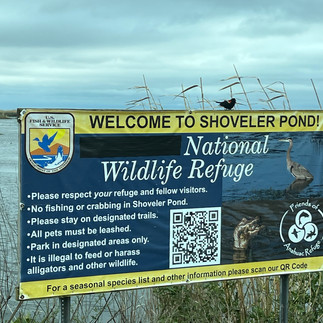Jocelyn Nungaray National Wildlife Refuge Visit
- Kimi's Travel Thoughts
- Apr 15
- 5 min read
Updated: Nov 5
People that know me often don't realize that I enjoy bird watching until I happen to see a bird doing something interesting and start naming bird facts. I'm not Audubon Society-level bird watching, but I consider myself a casual bird watcher. When I was in middle school, I signed up for an environmental science elective and my teacher was a true avid bird watcher. He taught us a lot about birds and even purchased binoculars for the class so we could go into the woods behind the campus to do some bird watching. I took an optional field trip to a North Houston nature reserve and I was hooked on bird watching! At the end of the year, my teacher gave me a book of North American birds which encouraged me to continue looking at my surroundings for any birds I haven't seen before. As I see birds that are new to me, I place a small star next to them in the book.
Since middle school, I wanted to visit the Jocelyn Nungaray National Wildlife Refuge (formerly known as the Anahuac Wildlife Refuge). However, something always seemed to come up that would prevent me from going. This time was different. I was determined to finally make it to the wildlife refuge to do some bird watching and check out the other wildlife inhabiting the land.

What You'll Need for the Wildlife Refuge
For a trip to the Jocelyn Nungaray National Wildlife Refuge, I recommend these items:
comfortable closed-toe shoes
reusable water bottle
reef-safe or reef-friendly sunscreen*
long sleeves and/or pants to protect from mosquitos
hat or visor
sunglasses
camera
binoculars
snacks for the car
wildlife viewing checklists
*Pro Tip: Reef-safe sunscreens generally are not super cheap. However, CVS brand sunscreens are reef safe and available at an affordable price! When purchasing sunscreen, make sure that oxybenzone and octinoxate are not in the ingredients list -- that's how you know it's reef-safe or reef-friendly.
Arriving, Parking, and Navigating the Wildlife Refuge
When you arrive at the Jocelyn Nungaray National Wildlife Refuge, you will see a large, wooden sign at the entrance after winding your way through a series of two-lane roads off Interstate 10. As I drove up, I found parking in the designated spots by the welcome center and got out the car to read the signage and pick up pamphlets to get my morning at the wildlife refuge started.
The butterfly garden was right by the parking lot, so I went there first. The butterflies were not out because the flowers have not bloomed yet and I went on a day when it was cool after a cold front moved into the area. However, I did see a variety of birds that were largely unbothered by my presence and would fly past me almost as if I wasn't even there. Beyond the butterfly garden was a short, elevated hiking trail. As I set out on the trail, I thought I saw an alligator hiding under a log in the water. After walking the trail where I mostly saw more of the same birds from the butterfly garden and a couple of turtles, I doubled back to the parking lot and along the way noticed that the small "pond" where I thought I saw the alligator looked slightly different. There was indeed an alligator hiding under the log earlier and it left in the time I walked the hiking trail!
With the strong northern wind and the cooler weather, I wanted to stay in my car. There is an auto loop for people to simply drive a circular trail that is just under 3 miles to view waterfowl, alligators, and other forms of wildlife that have made the refuge home. The air temperature was so cool that morning that small sparrows and bluebirds were huddled up in clusters on the road to stay warm.
Once I finally got to the auto loop, I put on Jon Batiste's Beethoven Blues album and drove slowly to observe all the birds and alligators. I would pause at times to read signage about the wildlife along the way and I parked my car at the boardwalk to walk around and get a closer look at some of the waterfowl. I even got to see a flock of one of my favorite birds (and the reason why I went to the Jocelyn Nungaray National Wildlife Refuge) -- the roseate spoonbill! It's a beautiful, light pink bird with long legs and a long bill curved at the end to form a shape similar to a spoon. That was the cherry on top of a great morning!
What I Saw at the Jocelyn Nungaray National Wildlife Refuge
These photos are just a few highlights from my wildlife refuge visit. (I think it's time for me to invest in a real camera.) I plan to post more photos and some video content on Instagram where all my exclusive content lives. Be sure to follow me there if you want to see more images from this experience!




Wrap-Up
I only went to one area of the Jocelyn Nungaray National Wildlife Refuge because I was on a quest to see one specific bird. If you've been following my blog for a while, you might have noticed that I don't write about outdoor activities very often. The reason for that is environmental allergies which I experience throughout the entire year. However, I do like to be outside on a day when I can manage being outside a bit better and, fortunately, this wildlife refuge visit was the perfect day! I might not spend a ton of time outdoors, but I appreciate nature and my morning at the wildlife refuge is about as ideal a start to the day as I could imagine: peaceful, cool, and educational.
Oh, and there are other areas to explore at the wildlife refuge include an area for camping and one for boats! If you're looking for a fun day trip or short weekend getaway solo, with family, or with friends, the wildlife refuge is very affordable (you mostly pay for gas to get there because admission is free) with plenty to see and learn about. If there's a wildlife refuge not too far from wherever you live, I highly recommend going to take in the views of wildlife while you can because these animals lose more and more of their natural habitats each year. Each wildlife refuge helps preserve these ecosystems and the wildlife they sustain, so it's important to patron and advocate for these spaces as they serve a critical function in protecting the environment.








